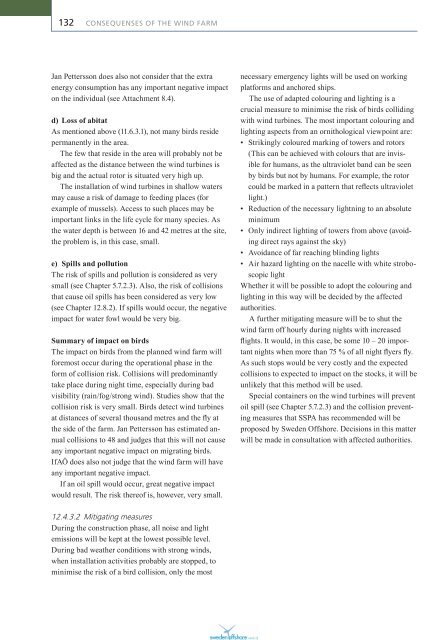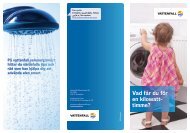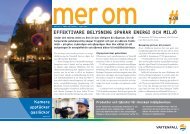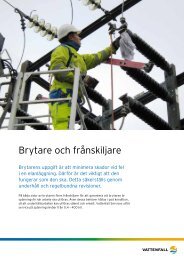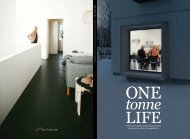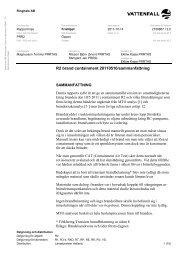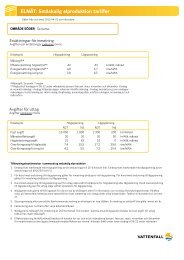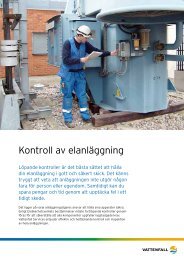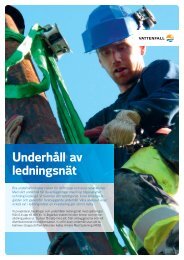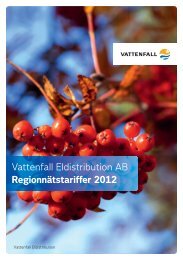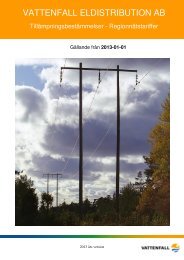This environmental impact assessment for Kriegers flak ... - Vattenfall
This environmental impact assessment for Kriegers flak ... - Vattenfall
This environmental impact assessment for Kriegers flak ... - Vattenfall
You also want an ePaper? Increase the reach of your titles
YUMPU automatically turns print PDFs into web optimized ePapers that Google loves.
132 CONSEQUENSES OF THE WIND FARM<br />
Jan Pettersson does also not consider that the extra<br />
energy consumption has any important negative <strong>impact</strong><br />
on the individual (see Attachment 8.4).<br />
d) Loss of abitat<br />
As mentioned above (11.6.3.1), not many birds reside<br />
permanently in the area.<br />
The few that reside in the area will probably not be<br />
affected as the distance between the wind turbines is<br />
big and the actual rotor is situated very high up.<br />
The installation of wind turbines in shallow waters<br />
may cause a risk of damage to feeding places (<strong>for</strong><br />
example of mussels). Access to such places may be<br />
important links in the life cycle <strong>for</strong> many species. As<br />
the water depth is between 16 and 42 metres at the site,<br />
the problem is, in this case, small.<br />
e) Spills and pollution<br />
The risk of spills and pollution is considered as very<br />
small (see Chapter 5.7.2.3). Also, the risk of collisions<br />
that cause oil spills has been considered as very low<br />
(see Chapter 12.8.2). If spills would occur, the negative<br />
<strong>impact</strong> <strong>for</strong> water fowl would be very big.<br />
Summary of <strong>impact</strong> on birds<br />
The <strong>impact</strong> on birds from the planned wind farm will<br />
<strong>for</strong>emost occur during the operational phase in the<br />
<strong>for</strong>m of collision risk. Collisions will predominantly<br />
take place during night time, especially during bad<br />
visibility (rain/fog/strong wind). Studies show that the<br />
collision risk is very small. Birds detect wind turbines<br />
at distances of several thousand metres and the ß y at<br />
the side of the farm. Jan Pettersson has estimated annual<br />
collisions to 48 and judges that this will not cause<br />
any important negative <strong>impact</strong> on migrating birds.<br />
IfAÖ does also not judge that the wind farm will have<br />
any important negative <strong>impact</strong>.<br />
If an oil spill would occur, great negative <strong>impact</strong><br />
would result. The risk thereof is, however, very small.<br />
12.4.3.2 Mitigating measures<br />
During the construction phase, all noise and light<br />
emissions will be kept at the lowest possible level.<br />
During bad weather conditions with strong winds,<br />
when installation activities probably are stopped, to<br />
minimise the risk of a bird collision, only the most<br />
necessary emergency lights will be used on working<br />
plat<strong>for</strong>ms and anchored ships.<br />
The use of adapted colouring and lighting is a<br />
crucial measure to minimise the risk of birds colliding<br />
with wind turbines. The most important colouring and<br />
lighting aspects from an ornithological viewpoint are:<br />
• Strikingly coloured marking of towers and rotors<br />
(<strong>This</strong> can be achieved with colours that are invisible<br />
<strong>for</strong> humans, as the ultraviolet band can be seen<br />
by birds but not by humans. For example, the rotor<br />
could be marked in a pattern that reß ects ultraviolet<br />
light.)<br />
• Reduction of the necessary lightning to an absolute<br />
minimum<br />
• Only indirect lighting of towers from above (avoiding<br />
direct rays against the sky)<br />
• Avoidance of far reaching blinding lights<br />
• Air hazard lighting on the nacelle with white stroboscopic<br />
light<br />
Whether it will be possible to adopt the colouring and<br />
lighting in this way will be decided by the affected<br />
authorities.<br />
A further mitigating measure will be to shut the<br />
wind farm off hourly during nights with increased<br />
ß ights. It would, in this case, be some 10 – 20 important<br />
nights when more than 75 % of all night ß yers ß y.<br />
As such stops would be very costly and the expected<br />
collisions to expected to <strong>impact</strong> on the stocks, it will be<br />
unlikely that this method will be used.<br />
Special containers on the wind turbines will prevent<br />
oil spill (see Chapter 5.7.2.3) and the collision preventing<br />
measures that SSPA has recommended will be<br />
proposed by Sweden Offshore. Decisions in this matter<br />
will be made in consultation with affected authorities.


